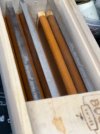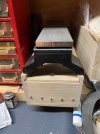I've got a new 8" Dia-Sharp Fine benchstone that I plan to use to learn freehand sharpening (I've previously been using a Lansky guided system). Last night I practiced by sharpening, dulling, and resharpening an inexpensive chef's knife several times for practice, and it worked well enough: it quickly raised a burr that I was able to remove with my 3 micron strop for a decent edge. The stone feels really coarse, though (similar to my Lansky system's 280 grit stone), and the edges it creates have pretty deep scratches in them. Is this normal for a DMT stone that hasn't been broken in? What's the best way to break it in so that I can feel comfortable using it on my more expensive knives? How long does it usually take? Any advice would be appreciated.
Last edited:


